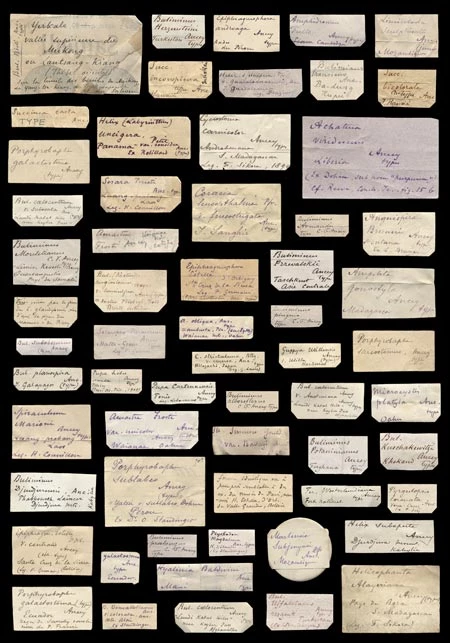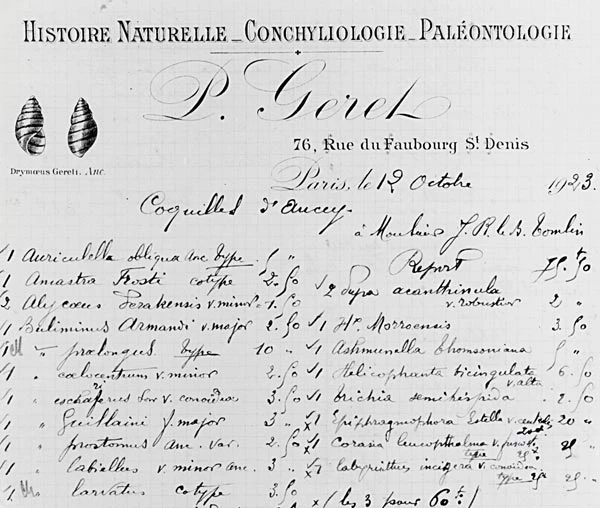A great shell collector's work is finally brought together
A specimen plate from the The New Molluscan Names of César-Marie-Felix Ancey
Amgueddfa Cymru’s mollusc collections are of international significance, and contain hundreds of thousands of specimens. In 2008 the definitive book on the work of the great collector César-Marie-Felix Ancey (1860–1906) was produced.
César-Marie-Felix Ancey named many land and freshwater species new to science. A portion of his collection came to Amgueddfa Cymru in 1955, as part of the Melvill-Tomlin collection.
Museum staff have been researching Ancey’s collection, held in museums across the world, since 2004 and have now produced the most up-to-date and comprehensive list ever of his new scientific names and publications. It forms a reference tool for specialists and researchers worldwide.
Examples of Ancey’s handwritten collection labels
César-Marie-Felix Ancey (1860–1906)
Geret’s sales list, selling some of Ancey’s collection to Tomlin
César-Marie-Felix Ancey
César-Marie-Felix Ancey was one of the great Victorian collectors and made a huge contribution to science in his short life.
Born in Marseille, France, on 15 November 1860, he showed a keen interest in natural history from an early age. He created his own collection of shells and later wrote and published many papers on conchology.
Aged 23 he was appointed conservator of the Oberthur entomological collections at Rennes, France. He later returned to Marseille to study law, literature and science, and successfully obtained his diploma in 1885.
Two years later he entered the government in Algeria. After 13 years hard work he was promoted to acting administrator at Mascara in Western Algeria. All his mollusc studies were done in his spare time.
Specimens from across the globe
Ancey’s main interest was in small land snails. Through exchange and purchase he collected specimens from all over the world. The Pacific and Asia are particularly strong in his collection, but it also covers Europe, North and South America and Africa.
It was Ancey’s great desire to make a scientific journey to the Cape Verde Islands or South America, but sadly this dream was never realised as Ancey died of a fever at the young age of 46.
The collection gets split up
After Ancey’s death his entire collection went to Paul Geret, a shell dealer, who sold it on in 1919 and 1923. It was at this point that the collection was split up — the great private collectors of the time, Tomlin, Dautzenberg and Connolly among others, all competed for a part of it.
A majority of Ancey’s specimens are now held at Amgueddfa Cymru (Cardiff: Melvill-Tomlin collection), the Royal Belgian Institute of Natural Sciences (Brussels: Dautzenberg collection), Muséum National d’Histoire Naturelle (Paris), Bernice P. Bishop Museum (Honolulu) and the Natural History Museum (London: Connolly collection).
A tribute to Ancey’s achievements
In 1908 a list of his mollusc publications was produced, shortly followed by a separate list of the scientific names he had published. These two publications indicated that Ancey had described some 550 scientific names in over 140 papers. The problem was that neither of these lists were complete, and this has caused difficulty to researchers in this field of science ever since.
Staff at Amgueddfa Cymru have now located all of Ancey’s papers to form a comprehensive bibliography listing 176 publications and within these we have identified 756 new scientific names.
From trawling the Melvill-Tomlin collection we know that nearly 300 of these names are represented in our collection of Ancey specimens and that we hold type specimens of 155 of these.
The result of this research is The New Molluscan Names of César-Marie-Felix Ancey, the most complete access to Ancey’s work that has ever been available.
Now the true extent of Ancey’s contribution to science and conchology can be revealed, helping to make his collection more accessible to the scientific community worldwide.




Comments - (1)
Also, I need an image with at least four views of Cookeconcha thwingi (Ancey, 1904). If you have a specimen of drawing, would you consider imaging it for me. I am almost finished with a revision of the Hawaiian genus Cookeconcha and need types of the described species.
Please let me know.
Mike